CIR-Engineering
10 µW
Hi All,
As in my signature, I have a TurboAnt N1 48 volt bike. I want to defeat the LVC on the bike's controller because it's supposed to cutoff at 40v +/- 1volt, but it's shutting me off at 43.7 volts as measured with my FLUKE DMM. I have been trying to get TurboAnt to send me a new controller, but with the language barrier, and possibly their willful ignorance they have not. The battery its self has a very smart BMS and agrees that the battery still has plenty to give. Yes, the bike doesn't have nearly as much oomph at these lower voltages, and yes I know it's better not to run a battery down too low. However, at 43.7 volts the controller is being way to overprotective and there are occasional times when I need the extra range to limp home after a long ride. Normally it wouldn't matter, but sometimes I need the extra juice sitting in the battery.
The controller is odd and I cannot find reference to it anywhere. I de-potted it and removed the large capacitor so that I could see what is going on in there. Unfortunately, it's not obvious to me what parts are for sure the LVC based on what I can see so far. I have some suspicions though, and I have only de-potted half of the unit so far because it's my understanding that the LVC circuit is usually located close to the positive input directly from the batter. Below are photos (red wire is positive and green is negative):
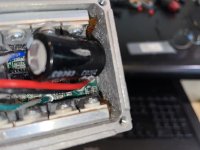
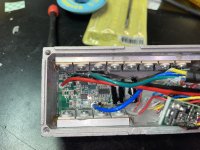
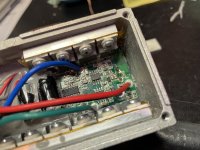
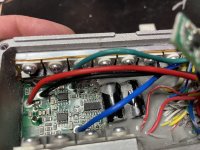
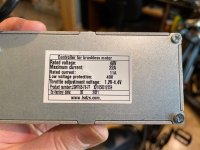

I suspect the pair of resistors marked 2R0 or the pair marked 103 to have control over the LVC. These resistors are located near a couple transistors and the IC's which may be the voltage comparator circuit.
Any input or suggestions on figuring out how to lower or defeat the LVC would be greatly appreciated. Is there another controller that is similar to this one? I can't find anything that resembles it anywhere.
Thank you!
As in my signature, I have a TurboAnt N1 48 volt bike. I want to defeat the LVC on the bike's controller because it's supposed to cutoff at 40v +/- 1volt, but it's shutting me off at 43.7 volts as measured with my FLUKE DMM. I have been trying to get TurboAnt to send me a new controller, but with the language barrier, and possibly their willful ignorance they have not. The battery its self has a very smart BMS and agrees that the battery still has plenty to give. Yes, the bike doesn't have nearly as much oomph at these lower voltages, and yes I know it's better not to run a battery down too low. However, at 43.7 volts the controller is being way to overprotective and there are occasional times when I need the extra range to limp home after a long ride. Normally it wouldn't matter, but sometimes I need the extra juice sitting in the battery.
The controller is odd and I cannot find reference to it anywhere. I de-potted it and removed the large capacitor so that I could see what is going on in there. Unfortunately, it's not obvious to me what parts are for sure the LVC based on what I can see so far. I have some suspicions though, and I have only de-potted half of the unit so far because it's my understanding that the LVC circuit is usually located close to the positive input directly from the batter. Below are photos (red wire is positive and green is negative):






I suspect the pair of resistors marked 2R0 or the pair marked 103 to have control over the LVC. These resistors are located near a couple transistors and the IC's which may be the voltage comparator circuit.
Any input or suggestions on figuring out how to lower or defeat the LVC would be greatly appreciated. Is there another controller that is similar to this one? I can't find anything that resembles it anywhere.
Thank you!

